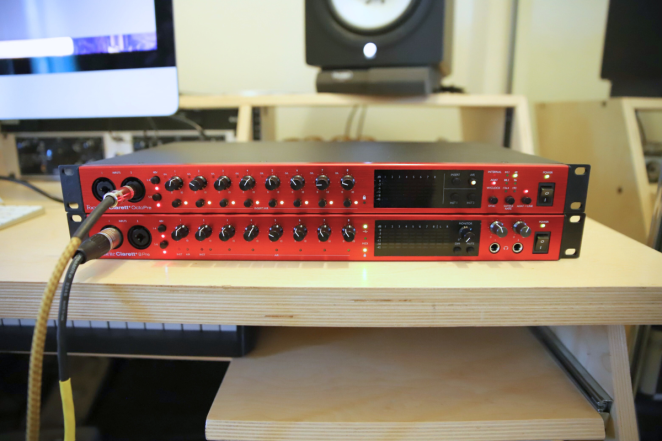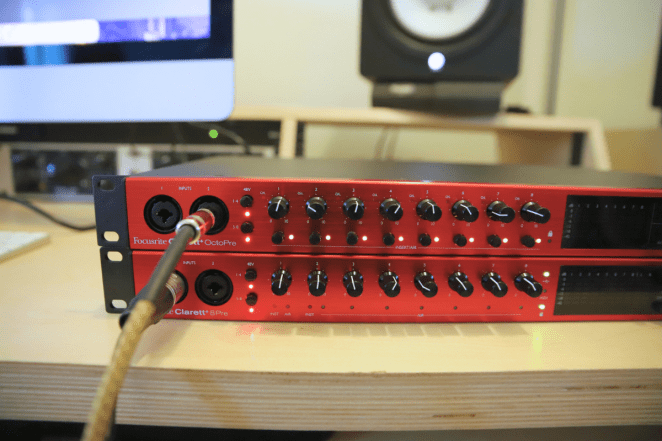You’ve been getting along for a while with that cluttered desk, discount speaker set, and budget interface that records one instrument at a time. But you’re not making rap songs with beat loops anymore. Your goals have officially outgrown your setup, and you need to make the jump into something bigger.
For most people, this starts with upgrading their audio interface to something that can take more than one input—say, eight. Besides providing exceptional noise reduction and clarity of sound, Focusrite’s Clarett+ 8Pre allows you to record up to eight separate inputs at a time—or 16 if you pair it with the OctoPre.
The 8Pre is not a cheap piece of hardware, but it’s one of the best audio interfaces available on the market today. If you’re trying to decide whether the 8Pre is right for your setup, you’ll have your answer by the end of this article.
I spent some time in my brother’s studio with the 8Pre and its cousin the OctoPre, so I’m going to give you a firsthand review of where these products excel.
Let’s get to it.
Overview

The Focusrite Clarett+ 8Pre is an ultra high-performance audio interface designed for established producers and audio engineers who need to level up (say, from something like an M-Audio) and bring true studio-quality sound into their work.
Whether you’re tracking live instruments, recording vocals, mixing, or even mastering, the 8Pre provides clarity, presence, and a pure analog sound for the most professional-quality audio productions.
It has eight inputs, ten outputs, and MIDI compatibility. It also comes with an Ableton Live Lite subscription, three months free of Pro Tools Artist, and the Hitmaker Expansion software, which gives you plugins from a variety of renowned audio production brands.
Why I Like It
- The 8Pre provides astounding noise reduction and reduced hum, in large part due to its low distortion converters.
- When paired with the OctoPre, the 8Pre can take 16 separate inputs, which is usually more than enough even for full-band studio sessions.
- The 8Pre comes with a three-year warranty and lifelong customer support.
Features & Benefits

Let’s get gritty and go over some more specific features and benefits, so you know exactly what to expect from the Clarett+ 8Pre.
There’s so much to talk about when it comes to the best audio interfaces, but we’ll stick to the three heavy hitters: audio quality, connectivity, and preamps.
Audio Quality

Quite obviously, audio quality is the most important metric to consider when buying a new audio interface. Whether you’re recording an electric guitar or singing into a mic, you’ll want the clearest, most accurate recording possible.
But more goes into this than you might imagine. Mics record sound in an analog format, which then needs to be converted into a digital format so you can edit it in Logic Pro (or whatever your preferred DAW is). Then when you’re ready to listen, the files have to be converted back to analog so the sound can be played through your speakers or headphones.
Part of the reason the 8Pre sounds so good is because of the quality of its independent A-D and D-A converters (A-D meaning “analog to digital”, and D-A meaning the opposite). This is a complicated technology that not all interfaces are able to nail down. The 8Pre’s converters give it a huge dynamic range (up to 124dB) and low distortion, which all results in incredibly high-fidelity sound.
And I can prove it, too. I recorded some vocals into both my Clarett+ 8Pre and my brother’s M-Audio M-Track 2X2. We both heard the difference clear as day: The 8Pre’s recording was much brighter, clearer, and came with less background hum.
With audio quality of the 8Pre’s caliber, you can have much greater confidence that your final output will accurately reflect your creative intentions, and you’ll probably end up spending much less time mixing and messing with EQ in post.
Connectivity

Connectivity refers to the selection of inputs and outputs available in an interface.
Like I mentioned earlier, a 2-in / 2-out interface is fine if you’re looking to lay down some demos or if your music relies heavily on digital production via samples and loops. But if you’re looking to record your full band at the same time or individually mic up your 10-piece drum kit, that’s just not going to cut it.
The 8Pre allows you to record a total of eight inputs simultaneously (either XLR or quarter-inch), with 10 separate outputs that can each be routed to a separate studio speaker. To put it in perspective, this is enough for a standard rock band, which usually includes one or two vocal inputs, three instrument inputs, and a three or four inputs for the drum kit.
One of the 8Pre’s greatest strengths is its ADAT expansion capabilities. ADAT allows you to add additional audio channels to your existing interface, expanding the number of inputs and outputs for recording and playback. Focusrite does this very well with its OctoPre preamp—more on this in a later section.
The Clarett+ 8Pre has basically everything you could want in the connectivity department: On its own, you’ve got 8-in / 10-out with both XLR and quarter-inch inputs, plus flexible expansion possibility via ADAT.
Preamps
Technically speaking, preamps amplify low-level audio signals, such as those from microphones or instruments, to line-level signals that can be processed and recorded. But as far as the recording artist is concerned, preamps are what provide the first layer of warmth, character, and uniqueness to your otherwise raw audio.
The 8Pre offers eight Clarett preamps, two of which are Hi-Z JFET instrument inputs. These are designed to handle signals from high-impedance sources, like electric guitars and basses, without losing signal strength or buzzing with noise.
The high point of the 8Pre’s preamp functionality is undoubtedly its Air mode. When you switch the 8Pre to Air mode, it will record everything entirely analogue, which adds a lift in the high frequencies, providing a brightness and presence similar to that of Focusrite’s legendary ISA mic preamps.
This is another thing I noticed when using the 8Pre myself. Whether I was recording acoustic guitar or vocals, Air mode added a certain, almost indefinable character to the sound which really brought it to life.
This isn’t to say Air mode is necessarily better than standard mode—it all depends on what sound you’re going for. Standard mode is the best for neutral, accurate sound capture, whereas Air mode will give you an extra brightness and slightly more vintage-sounding tone.
Expansion Capabilities

A hallmark of Focusrite’s Clarett+ line is its ADAT compatibility. With ADAT, you can add more inputs to the same interface, as opposed to having to use two or get a new, bigger one.
Focusrite does this with the Clarett+ OctoPre, which is an 8-in / 8-out preamp that integrates flawlessly with the 8Pre (as well as any interface with ADAT I/O). Simply connect the two via ADAT cables, and you’ll now have a total of 16 separate inputs you can use for simultaneous recording, and 18 total outputs.
The OctoPre comes with many of the same features as the 8Pre, including Air mode and the same high-quality A-D and D-A converters. It also has a few extra perks of its own, including the ability to choose your sample rate (44.1, 48, 88.2, 96, 176.4, or 192) directly from the preamp.
Here’s why the OctoPre is so helpful, minus the technical jargon. Let’s say you’ve been about 99% sure about buying the 8Pre, but you’re worried that your studio will only keep growing, and your recording needs will follow suit. You outgrew two inputs fast enough—who’s to say you won’t outgrow eight in another year or two?
Well, now that you know the OctoPre is a thing, you won’t need to make the hard choice of paying $2,000 to get a 16-input whopper right off the bat. You can buy the 8Pre, cater to your existing needs, and rest easy knowing you can expand to 16 inputs at any time in the future with the OctoPre.
Things To Consider Before Buying
Clearly, the Clarett+ 8Pre handily solves a variety of key problems you might be experiencing in your existing studio.
You can record eight separate instruments at the same time (16 when paired with the OctoPre), which enables full-band setups, drum tracking, and other complex studio configurations. Its high-quality A-D / D-A converters and preamps result in clear, accurate recordings with low distortion and noise.
- Buy the Clarett+ 8Pre if you’re an established producer, engineer, or musician looking to level up from a basic interface. If you need to record from multiple sources at once and you want the highest-quality, lowest-noise recordings possible, the 8Pre was literally built for you.
- Check out our Focusrite Scarlett 2i2 review if you’re a beginner or you’re looking to record simple demos or loop-based music. If this is you, I highly recommend sticking with a basic 2-in / 2-out interface until your studio is established enough to upgrade to the 8Pre.
If you fit into the first category, here are a few more things to keep in mind before pulling the trigger:
- Studio space: The 8Pre is pretty big and heavy. Make sure you have enough desk space, and consider buying a studio rack if you don’t have one yet.
- Genre-specific needs: Different genres sometimes require different input types. For example, if you produce electronic music, the 8Pre's analog inputs probably won’t be super necessary, but its digital inputs will be. On the other hand, genres with a heavy acoustic element would benefit greatly from the eight analog inputs.
- Budget: For what you’re getting, the 8Pre is priced very competitively at $999.99. Other interfaces with similar capabilities can easily go for $2,000+. Though a grand is still a pretty hefty investment, you’re quite literally getting something that’s double the value of what you’re paying. And if it allows you to produce more bangers, it’s usually worth it. If money is tight or you have just started out, go for the best budget audio interface: it won't be of the same quality but it won't break the bank.
The Verdict
The Clarett+ 8Pre is the perfect next step up for the artist or recording engineer looking to upgrade to a truly studio-grade audio interface.
With eight inputs, you can say goodbye forever to those time-consuming sessions where you’re recording all your instruments one at a time. Couple that with the 8Pre’s all-analogue Air mode, top-quality independent A-D and D-A converters, and 16-input expansion potential with the OctoPre, and you’ve got one of the few premier studio-quality audio interfaces on the market today—and at a very reasonable price point.
Having tested the 8Pre and OctoPre myself, I can personally vouch for everything discussed in this article. The 8Pre and OctoPre are pristine pieces of hardware, and there’s a reason why they’re used by some of the biggest names in the music business.

